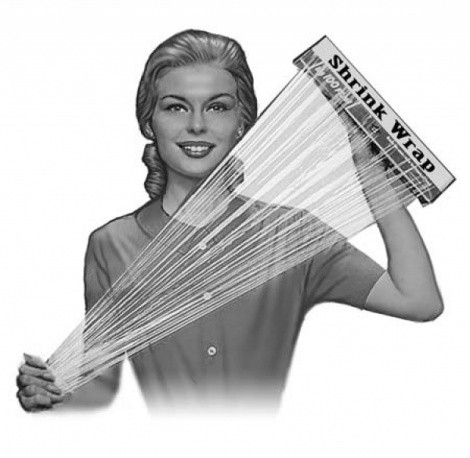
I don’t know why people complain about shrink-wrap. You’d think it was the bane of modern civilization, the way some people go on about it.
Almost anything can be shrinkwrapped: soap, CDs, candles, vegetables, magazines, books, clothes, toys, medical devices, tools and all sorts of miscellaneous gizmos. Just last week, I read about a local company that does a thriving business shrink-wrapping large boats and even giant tires. It doesn’t immediately occur to you that boats and tires need to be shrinkwrapped, but it makes a lot of sense once you think about it, especially for tires.
There’s something very appealing about shrink-wrap. For one thing, it bespeaks purity. You know that under the glossy film of polyolefin lies a pristine product, whether animal, vegetable or mineral. I thought about this the other day when I was shopping at Albertsons for cucumbers to be served with salami as a cocktail snack. There on a shelf above the normal cucumbers was a neat stack of hothouse cucumbers, each of them snugly wrapped in prophylactic plastic.
It was reassuring to know that the alluringly wrapped cuke hadn’t been stroked and fondled by who knows how many grubby-fingered grocery shoppers. Besides the purity factor, there is the often-overlooked aspect of tactility. The shiny polymer is smooth to the touch, and there is the special pleasure of divesting the product in question—in this case a cucumber—of its protective wrap, whether by pulling at the seams or slitting with thumbnail.
(Note: Most shrink-wrapped products yield easily to divestment; vacuum-packed or blister-packaged products are frequently difficult to deal with and often result in fractured fingers and broken marriages.)
Magazines account for a substantial portion of the shrink-wrap market, and with good reason. The consumer gets the usual satisfaction of stripping the magazine of its plastic envelope; but more than that, he or she obtains the pleasing illusion of being the first to cast eyes upon the content. No one wants to buy a well-thumbed magazine; discovering an ink-smeared thumbprint on page 39 is equivalent to finding a hair in your cheese omelet.
(There is, apparently, a small, but thriving market in shrink-wrapped fetish magazines that specialize in photographs of shrinkwrapped nude people engaged in a variety of activities, wholesome and otherwise.)
The market for shrink-wrap is increasing every day, and with market demand, the shrink-wrap industry is making great strides in shrink-wrap technology. Insiders are confident that in the near future each and every product will be packaged and protected by shrink-wrap. Already plans are underway to move shrink-wrap aggressively into new market segments, principally those associated with health care.
For example, with anticipated shortages of swine-flu vaccinations, shrink-wrap entrepreneurs have been test-marketing a new biodegradable shrink-wrap for use in elementary schools. According to Fred Milestrup, marketing director for Shrinking Your World With Shrink Wrap, a start-up headquartered in Elko, Nev., the coming swine flu epidemic presents a great opportunity for the shrink-wrap industry.
“We all know how hard it is for young kids to sit still, and we know that kids in particular have no sense of sanitation. So we have developed a product that kills two birds with a single sheet of polymer, so to speak. Our scientists have come up with a second generation of polyolefin with bidirectional shrinkage and fortified with laminated co-extrusions. We can wrap kids with this new stuff and they hardly notice it, at least once they get used to some difficulties with breathing.”
Mr. Milestrup claims his company’s new shrink-wrap has proven quite effective in stopping the spread of swine flu. He is also excited about a more hush-hush project his company hopes will address the bur geoning costs of health care in our country.
“No one wants to spend any money on health care for poor folks who haven’t taken care of themselves and can’t afford to go to the doctor. So we’ve been working with the insurance companies on cheap shrinkwrap that will be readily available to the uninsured. It will protect them from most bacteria and a few viruses, so they won’t be running to the emergency room whenever they get a cough or stomach ache. Best of all, we won’t need the so-called public option that will take away all the hard-earned profits of the insurance companies.”
Nevertheless, people without health care will die faster than those with it, and cheap, affordable shrink-wrap constitutes an excellent alternative, given its preservative qualities, to bulky and often expensive coffins.